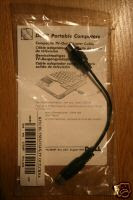No, I didn't invent anything over here. While in the process of setting up a home entertainment system, I preferred not to buy anything in haste. In India, the home entertainment portfolio is under major revamp now. LCD's and Plasma's are entering the home entertainment market in a big way. The prices of the TV's and home theater systems are crashing down.
In the meantime, to enable me watch my favorite movies, I was in need of a stop-gap solution. I thought of using my laptop as a DVD player and connecting its video-o/p to the TV. The following are the steps to connect Dell Latitude D600 laptop to Sony 29" CRT TV.
What you need?
1. Dell S-Video to Composite TV out adapter. (You get this adapter normally with the laptop)

2. Composite video cable (You can purchase one from your local electronics store)

How to connect?
1. Connect the S-Video to Composite TV out adapter in your laptop S-video output.
2. Connect one end of you composite video cable to the S-Video to Composite TV out adapter
3. Connect the other end of your composite video cable to your TV video input
4. Switch the TV to appropriate Video mode
5. Boot your laptop
6. Go to Control Panel > Display > Setting tab (Win XP OS)
7. Right click 2nd display and attach it.
8. Set the resolution and color properties. (Generally the TV supports 800x600 resolution. Sony 29" TV supported 1280x780 resolution with 32 bit Color)
9. You will see the extended desktop.
The TV screen behaves like a extended monitor. Drag the applications you want to run into the TV screen.
This way you can run movies from your laptop on to your TV screen. In order to get your audio output into your TV, you need to take the audio out from the headphone-jack in your laptop to your TV audio input.
P.S: It is imperative that you get a properly insulated composite video capable. Otherwise when you connect the power chord to your laptop, you shall get electrical noises in your video signal
Links:
Dell Documentation
HP India site documentation
S-Video site
11 comments:
But the S-Video cable seems proprietary. For example, DELL uses its own specific format for the S-Video cable.
hi Raja kumar, thanks a lot for these detailed steps. This really helped me a lot in connecting my laptop to my TV and it worked like a charm. You are Awesome. Thanks Again.
Hi rajkumar
i am trying to do this iwth m y sony tv..and what happens is i get an audio and an video...but the video appears in black and white...any ideas...thanks in advance
regards
madhu
Madhu,
I am not an expert at this. But you can check what is the Display Properties - Settings for your extended monitor (your TV acts like an extended monitor). See that you have proper resolution and color quality. You can also try troubleshooting with display drivers as well.
thanks a lot..i finally figured it out..there are laos certain settings that we got to do in the tv...we got to tell the television that it has to accept the s signal...
so we made some changes in remote control and then it worked...
thanks
madhu
hi mr raj..I am sebi..will u give me some advice to connect my lap to a crt philips tv..but i have only a vga port in my lap....is it possible
Hi Rajkumar,
I tried connecting my HP pavilion notebook pc to my Apex (At2008) tv the same way by using an s-video to rca and also used the function (fn) + f4 (video o/p) but nothing seem to work... please help!!!.. basically i am not a computer techie..
Regards
Vijay
Hi,
My Dell 1564 Laptop has got VGA and HDMI Ports. I am trying to connect to my CRT using VGA to 3RCA (RGB) cable. But my laptop is not recognizing the TV. Instead it reads Monitor.
I tried the steps suggested by you. but it doenst help.
Could you please help me.
Fake DVI Dual-Link cables. Dual-Link is a real thing, so don't get confused here; actually, it's one of the best three consumer display interfaces available right now (and its quality depends on the copper more than the standard, which has excellent implications for specific setups). The problem, though, is that a lot of manufacturers are selling "dual-link" cables that don't even have the extra pins wired! They have the dual-link pins, but if you cut the cable open, it's got no wires running between the pins. They're just dummy pins. Technically, the header is "dual-link," but the VGA Cable itself is single-link and won't support higher resolutions as expected.
A fiber-optic system is similar to the copper wire system that fiber-optics is replacing. The difference is that fiber-optics use light pulses to transmit information down fiber lines instead of using electronic pulses to transmit information down copper lines. Looking at the components in a fiber-optic chain will give a better understanding of how the system works in conjunction with wire based systems.At one end of the system is a transmitter. This is the place of origin for information coming on to fiber-optic lines. The transmitter accepts coded electronic pulse information coming from copper wire. It then processes and translates that information into equivalently coded light pulses.Think of a VGA Cable in terms of very long cardboard roll (from the inside roll of paper towel) that is coated with a mirror on the inside.If you shine a flashlight in one end you can see light come out at the far end - even if it's been bent around a corner.
Post a Comment